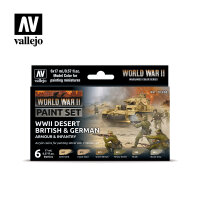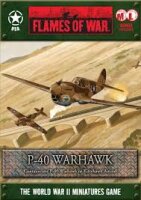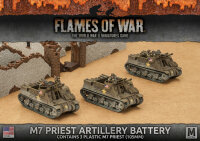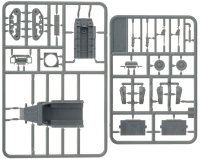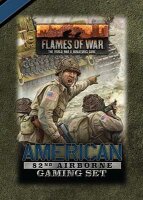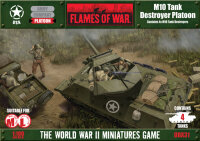Fighting First: US Forces in North Africa 1942-1943
(FW243)
Fighting First is 52 pages and covers the American forces fighting in North Africa through the Tunisian campaign.
The Mid-War Americans date right back to the first version of Flames Of War, with the books Old Ironsides in 2003, covering armored forces, followed by Stars and Stripes in 2005, which added infantry forces.
A lot has changed since then, of course, and the latest book brings the US Army up to date with the most recent edition of the rules. In doing so, it will bring a lot of added variety to Mid War battlefields, which is sure to be welcome.
Fighting First covers the US forces in North Africa throughout Tunisian Campaign, from the initial landings in Operation Torch, through their painful baptism of fire at Kasserine Pass, their redemption in the Battle of El Guettar and the eventual triumph with the final defeat of the Axis with the capture of Tunis.
We put a lot of thought into the name for this book. One option was to revisit the title of one of the older books, as we did with Desert Rats—something which gives a nice sense of continuity. However, neither title was quite right. Old Ironsides, the nickname of the 1st Armored Division, is great for a tank-focused book, but leaves out the infantry, which are just as much an important part of the book.
I’m very happy with 'Fighting First'. Obviously it alludes to one of the famous nicknames of the 1st Infantry Division, perhaps better known as the ‘Big Red One’. However, it fits just as well with the 1st Armored, and indeed all of the US forces in the campaign. They were the first American boots on the ground in the fight against the Nazis.
While the history in the book focuses on the 1st Armored Division and the 1st Infantry Division, you can equally run a force from any of the other US divisions (or the independent tank battalions) that participated in the campaign.
Many things haven’t changed much from what veteran players will be used to. But the way units and formations can be combined gives an increased level of flexibility and freedom.
As is now familiar in 4th Edition, a force must include at least one Formation. You can easily build pure tank forces or infantry combat teams, or you can mix the two together by having a formation of each, or as many smaller formations as your points limit will allow.
There are six formations available in Fighting First - the most options so far for a Mid War force.
The first three formation options are armored companies, which can include any of three models of tank: the M3 Light (aka the ‘Stuart’), M3 Medium (the ‘Lee’), and of course the M4 Medium (best known as the ‘Sherman’).
M4 Sherman Company
The most common model of Sherman in Tunisia was the M4A1, with its unmistakable rounded hull. It will be available as a brand new plastic kit.
Of the three tanks available in Fighting First, the Sherman is definitely the toughest, with the heaviest armour and the biggest gun. Its 75mm gun the best tank gun in mid war (barring the Tiger, which is really in a class of its own). Of course, at 8 points each, it is also the most expensive option.
M3 Lee Company
The M3 Medium tank, known as the 'Lee', is a balanced option—not as tough as the Sherman, but still a good match for most of the panzers it will face.
As many of your Lee tanks as you like can be upgraded for +1 point each to the long-barrelled 75mm gun, giving them the same high Anti-tank rating (10) as the Sherman.
M3 Stuart Company
Unlike the heavier cousins, both of the two compulsory platoons in the M3 Stuart Company must field M3 Stuarts. However, you can still substitute a M3 Lee or M3 Sherman platoon for one of the additional optional platoons if you wish.
The M3 Stuart is very fast. If you use that speed to rush your tanks into a position where the Stuarts’ light 37mm guns can exploit the enemy’s weaker side armour, you can do some real damage. It’s a tactic that takes guts, though, and you must expect to take casualties. The light tank companies tried to rely on their speed to avoid enemy fire. However, bitter experience taught them that while shock and surprise are effective tools, it was all too easy for enemy gunners to hit even a quick-moving target. Reflecting this, the Reckless Stuarts are hit on 2+.
Stabilisers
This rule comes from the gyrostabiliser devices which were standard for US tank guns. They helped keep the gun level while the tank moved, making it easier for a the gunner to keep the gun lined up with the target. For a sense of how big a difference this makes, watch a few videos of modern stabilised tank guns, which can hold eerily steady when compared to unstabilised guns bobbing wildly as the vehicle moves over terrain.
Of course, WWII-era stabilisers were not nearly as advanced, so moving will still affect the tank’s shooting performance, which is why there is a +1 to hit penalty. In previous versions of the rule it was phrased something you could choose to do, which created a quandry for a lot of inexperienced players. Because instinctively, it seems like the +1 to-hit penalty might sometimes be too high a price for an extra shot. The truth is, when you crunch the numbers, your odds are actually always better with the two shots at +1, so the stabilisers are actually always a boon, albeit not as obvious a one as the more modern iterations of the technology. But (most) wargamers don’t want to stand around calculating probabilities, so now there is no need to waste time wondering whether Stabilisers help or not—it simply applies whenever a US tank moves and shoots. The exception is the 37mm turret gun of the Lee, where the combination with its Secondary Weapon rule would introduce too much complexity.
Armored Rifle Company
Fighting First has two infantry formation options. The first, of these the Armored Rifle Company, rides to battle in M3 Half-tracks. The formation includes at least two Armored Rifle Platoons, and an optional third platoon.
Their Green skill rating (5+) keeps them from being overpowered when they assault—even more so for the bazooka teams, which need a 6 to hit. Even so, the large size of their platoons, not to mention the extra firepower from their LMGs, mortar and the machine-guns of the M3 Half-tracks, make them fearsome in attack or defence.
Unit leaders can act as spotters for the artillery—this differs from other forces, where only Formation commanders are equipped to do this.
With their plentiful weapons options, armored rifles have always been a versatile and popular choice for players of American armies. They have a well-earned reputation as a 'Swiss Army knife', able to perform well in almost any tactical situation. In 4th Edition, certain aspects have been subtly adjusted to bring them somewhat more in line with their real historical performance.
Of course, their point cost has been balanced accordingly, so they remain a highly effective formation, either as a force on their own or—even better—supporting a tank or tank destroyer formation.
Rifle Company
The foot infantry are less glamorous, but nevertheless a highly effective formation. Their large platoons will easily outnumber the enemy infantry, which is a big factor in the success of assaults, whether you are the defender or the attacker. Ans unlike the Armored Rifles, the foot sloggers aren’t burdened with so many heavy bazookas, which only hit on 6’s in the assault. So while they aren't as much of a threat to tanks, enemy infantry will be justifiably frightened.
To be effective, infantry can't always sit still on an objective. The ability to get to wherever on the table they are needed is often critical. And while the Rifle Platoons don't have cushy rides like their compatriots, their Truscott Trot lets them move faster than any other infantry across country.
Also, their ‘Determined’ rule lets them Rally more easily—so even if they are pinned down (and their unit size means this will take eight hits rather than the usual five) it will only take a 3+ to get them back up and moving again.
The company can also include up to two 37mm anti-tank platoons. These light guns are not very deadly to enemy tanks at range, but if you position them where they can support the infantry, their add defensive fire will make any armored assault against your positions a very risky proposition indeed.
M10 Tank Destroyer Company
With Anti-tank 12, the M10’s 3” gun certainly packs a wallop. If your opponent has Tigers, then the M10 tank destroyers will definitely be your most effective weapon of choice, to remind them that even the mighty Tiger is not invulnerable.
At least one US commander disapproved of the M10 because he worried its armour and turret would lead its crews to try to operate it like a tank. But remember, while the M10 has good armour, it is almost all on the front. From the side, it is no tougher than the humble Stuart, and its open top will see it wiped out quickly under artillery fire or if enemy infantry ever get close enough to assault it.
The best role for the tank destroyers is to make good use of concealing terrain and use their long 36”/90cm range to snipe at the enemy armour from a distance.
The HQ for the Tank Destroyer Company was supposed to be a pair of brand new, purpose-designed M8 armored cars, whose speed and mobility were perfect for guiding the tank destroyers wherever they would be most effective. However, the M8 was not ready in time for Tunisia, so the best substitute was a pair of M3 Stuarts. These are the same model as the Stuart Company, but they have a separate Unit Card, as a number of their stats are different because of how they operated. For one thing, they are much more cautious than their reckless cavalry counterparts—their job is to find targets and direct the tank destroyers, not to go charging into combat—so they are hit on 3+. If they do find themselves called on to shoot, they are hampered by the fact that the commander is on his own in the turret, so must act as his own loader, giving them the Overworked rule—a +1 to hit if the tank moved.
Seek, Strike and Destroy
This rule lets your tank destroyer units attempt a Shoot and Scoot movement order in the same turn that they successfully made a Blitz Move - an exception to the normal rule where units can only use one movement order in a turn. Creative tacticians who like to maximise tactical movement will find subtle and unpredictable ways of using this added movement flexibility, but its main use is fairly straightforward. In ideal conditions, your tank destroyers will be able start their turn hidden behind terrain, Blitz Move into position, fire at their full halted ROF, then scoot back out of harm’s way before the enemy can retaliate - more or less exactly how tank destroyer doctrine intended them to operate.
Nothing is certain, and this tactic won’t always work perfectly—as it relies on the unit passing its skill tests to make both Movement Orders—but the tank destroyers’ improved skill rating of 4+ help make it a powerful tactical option.
Armored Recon Patrol
One one hand, the Armored Recon Patrol is a handy supply of highly mobile machine-guns, which at the very least will force your opponent to think twice before leaving his infantry on their own
without some armoured protection.
Their main benefit, though, is their Spearhead rule, which can expand your deployment area, helping your force to start dominating the table before the table even begins.
Support for Fighting First includes plenty of powerful artillery, in the form of either the standard 105mm howitzer or its mobile, armoured counterpart the M7 Priest—both of which will be available as new plastic kits.
Time on Target
The US artillery have a special rule based on their ability to calculate the flight time of their shells, allowing them to strike the target in a devastating coordinated barrage before the unsuspecting enemy troops have a chance to take cover. If a bombardment from these units ranges in on the first attempt, enemy troops must re-roll successful saves.
Air Support comes in the form of the P40 Warhawk, the first aircraft in 4th Edition Mid War to give you a choice of bombs for heavy targets or .50-cal machine-guns to pick off infantry, guns or lighter armoured vehicles.
As usual, the book concludes with a painting guide to help you get your army looking great as quickly and easily as possible.
But it was in Africa that the US Army learned to fight. Nothing seasons a fighting force like real combat experience, and the American troops simply had none, unlike their enemies and their British allies alike, who had two solid years of fighting behind them. Although they had trained hard, everything was still theoretical for them. By the end of the campaign, their hard-won experience had shaped them into a formidable army. The victory in North Africa was also invaluable in cementing the resolve of the American people. Many in America, while sympathetic to the plight of Europe, did not believe the USA should get involved, except to fight the Japanese in the Pacific. But by March 1943 all eyes were on Africa, and victory for the US forces gave the nation something concrete to rally behind.
Battlefront Miniatures
